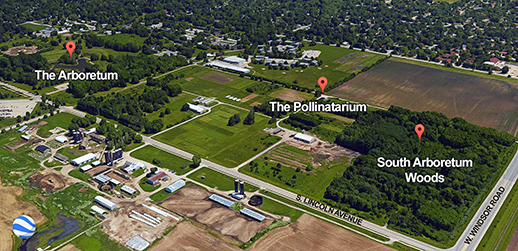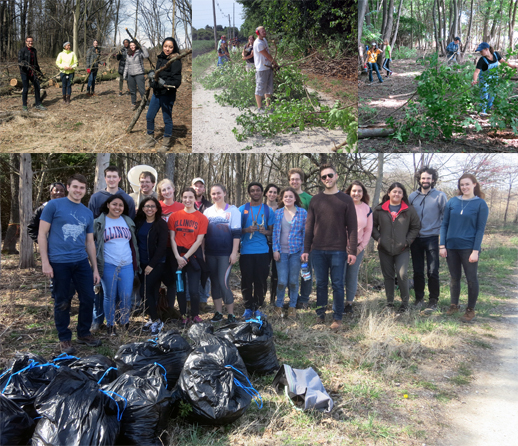
After two years a project to invigorate 22 acres near Windsor and Lincoln at the U of I is bringing the plot closer to its “natural” state.
T his high profile territory had become a thicket of brambles, invasive species, and dead plants. “I became disgusted,” said John Marlin, a research associate at Illinois Sustainable Technology Center who leads the project. “I drive by it every day on the way home. The honeysuckle was so thick that it was difficult to see more than five feet into the woods. The understory was shaded to the point that virtually nothing grew at ground level.”
his high profile territory had become a thicket of brambles, invasive species, and dead plants. “I became disgusted,” said John Marlin, a research associate at Illinois Sustainable Technology Center who leads the project. “I drive by it every day on the way home. The honeysuckle was so thick that it was difficult to see more than five feet into the woods. The understory was shaded to the point that virtually nothing grew at ground level.”
Marlin will serve as keynote speaker during Campus Appreciation Day at 5 p.m. Tuesday, April 11 in Room 1092 Lincoln Hall. Tuesday is Day Two of the University’s I Love Illinois Week. #ILoveIllinois. Marlin has attracted the interest of student volunteers for decades for sustainability projects across campus, including efforts to establish native plantings on campus to benefit indigenous animal species.
Funded by the Student Sustainability Committee, the 22-acre clean-up has attracted student volunteers from Red Bison, Students for Environmental Concerns, various other service organizations, East Central Illinois Master Naturalists, and members of the community. The property, now known as the South Arboretum Woods has been placed under the control of the Arboretum which will have long-term management responsibility.
Colleagues at the Department of Natural Resources and Environmental Sciences, the Illinois Natural History Survey, and Facilities and Services have also been key partners by consulting on maintenance issues at the site, Marlin said. Since 2015 groups have assembled to remove invasive species and clear debris to allow a comeback for native plants, insects and other organisms. Some areas have already been seeded with woodland and prairie plants.
All of that effort has put the project right on schedule with the wholesale removal of noxious plants to prepare the way for new plantings this spring, Marlin said. The tenacious villain honeysuckle blocks sunlight and kills native flowering plants (forbs) and bushes that normally occur in healthy woodlands. With the woody pest in retreat, the emphasis is now on preventing honeysuckle re-sprouts and dealing with smaller invasives like garlic mustard. Seeds of this plant have been dormant in the soil for years and are germinating in response to sunlight which can now reach the floor of the woods. Over the next few years a variety of trees, shrubs and forbs will be gradually introduced to sections of the woods.
The plan is to gradually introduce plants to the area as resources become available and problem plants are removed. This includes thinning the stands of trees found in the former research plot. They were planted close together in species plots to facilitate the study on plant diseases and insect pests. Decades later trees 18 inches in diameter are a mere five feet apart. Removing some of them will allow sunlight penetration and more normal growth. The initial planting will mainly occur on the east side of the woods where work began in 2015.
The planned plantings will run the gamut from sun loving to shade tolerant and will be selected to collectively bloom over the entire growing season with a variety of flower types. This will serve a large number of insects, many of which, like the monarch butterfly, require or prefer a limited number of plants. For example a leaf cutter bee (genus Megachile) was found in large numbers last fall on bellflower (Campanula americana) on the shady edge of the woods.
On the list for planting at the woods are Spring Beauty (Claytornia virginica), a wildflower Marlin said is used by 58 different kinds of bees. Others being planned include Purple Prairie Clover, Rattle Snake Master, Wild Geranium, Golden Rod and Aster, he added.
Mariln said he and Kevin McSweeney, director of the Arboretum, and Jay Hayak, extension specialist in forestry, have discussed the usefulness of the woods for teaching issues such as restoring biological diversity.
The area is not yet ready for public use and help in removing material from the area should only be done under supervision, Marlin said. Logs and other woody material will be left on the site to meet specific habitats requirements.


